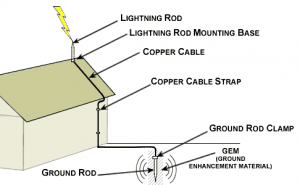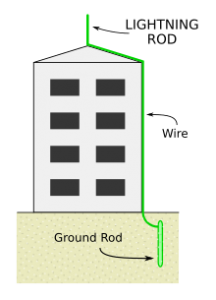The potential for lightning damage can be a major worry for building owners and managers. In the UK there are hundreds of injuries each year as a result of lightning strikes and the electrical surges that follow them. Therefore, it is vital that landlords meet the legal requirements for lightning protection to avoid putting anyone at risk.
What is a lightning protection system?
 Lightning protection systems are used to prevent or lessen lightning strike damage to buildings. They protect the internal electrical components of a building, helping to prevent fires or electrocution. Lightning protection comes in the form of a lightning conductor, usually a metal rod, mounted on a building to protect it from lightning strikes. The system will intercept a strike so if lightning hits the building, the lightning rod will be hit first, causing the strike to be conducted through a wire, and passing through to the ground safely.
Lightning protection systems are used to prevent or lessen lightning strike damage to buildings. They protect the internal electrical components of a building, helping to prevent fires or electrocution. Lightning protection comes in the form of a lightning conductor, usually a metal rod, mounted on a building to protect it from lightning strikes. The system will intercept a strike so if lightning hits the building, the lightning rod will be hit first, causing the strike to be conducted through a wire, and passing through to the ground safely. 
In a lightning protection system, the lightning rod is a single component of the system. The lightning rod requires a connection to earth to give a building protection. Lightning rods come in many different forms, including hollow, solid, pointed or rounded. All lightning rods are made of conductive materials, such as copper and aluminium.
 Because of the high energy and current levels associated with lightning a lightning protection system can never guarantee complete safety from the effects of lightning. In a lightning protection system, the current will divide to follow every conductive path to ground but even the divided current can cause damage. These secondary “side-flashes” can still cause a fire, blow apart brick, stone, or concrete, or injure anyone within a building.
Because of the high energy and current levels associated with lightning a lightning protection system can never guarantee complete safety from the effects of lightning. In a lightning protection system, the current will divide to follow every conductive path to ground but even the divided current can cause damage. These secondary “side-flashes” can still cause a fire, blow apart brick, stone, or concrete, or injure anyone within a building.
Why do I need a lightning protection system?
If you are a business owner you need to ensure you meet the correct regulations in relation to lightning protection. According to RC 35 ‘Protection of buildings against lightning strikes’, a risk control publication, it is not a legal requirement for all buildings and structures to have lightning protection. However, the Electricity at Work Regulations 1989 do apply to most businesses.
To find out how at risk your building is from lightning strikes and what your responsibilities are it is important to carry out a full risk assessment. Some buildings are more at risk of being struck by lightning than others. To calculate the risk for a structure we would look at the size of a building, it’s height, and the number of lightning strikes per year per mile for the region. So, a small building will be at less risk of being struck than a large one and a building in an area with a high density of lightning strikes will be more likely to be struck than one in an area with a low density of lightning strikes. According to BS EN/IEC 62305, it is mandatory to complete a risk assessment annually to ensure that your lightning protection system complies with the regulations.
Installing a lightning protection system is not only about obeying any necessary regulations. The application of lightning protection methods will help protect your building. Damage caused by lightning can lead to equipment downtime, costly replacements and a disruption to your business’s productivity. By installing protection methods, you will see economic and productivity benefits for your company.
How can Equiptest help me?
We can design and install a full lightning protection system. We will complete a full site survey and then use the results to design a system that would also include recommendations for surge protection. We would supply all materials, including surge protection devices. After installation we can undertake regular testing and maintenance.
We have seen a big increase in interest in this service over the last few years so remain experienced in installing lightning systems.
Contact us to find out more.

